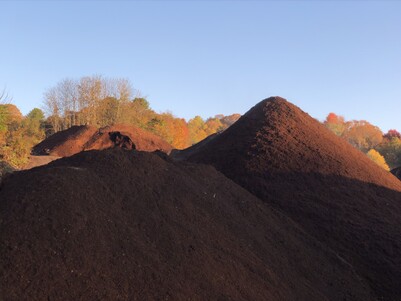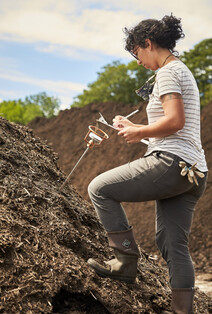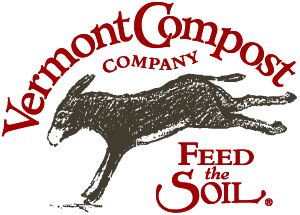The Compost 
Vermont Compost Company’s primary goal is to provide the highest quality composts and potting soils to growers, enabling them to realize their plant growing goals. The performance of any compost is determined by the content and structure of the materials being composted. Correct media behavior depends on good process conditions and practices. We use the broadest range of appropriate ingredients to support bio-diversity. Using a “multi-manurial” suite of excreta—cow, horse, donkey, mule, chicken, and worm manures—as well as community food residuals, bedding hay, spoiled silage, and hardwood bark, we move towards imitating the complexity of successful natural systems. We make our compost on native soil surfaces amended to optimize the compost process and intended to return to tillage in the enhanced form if and when the need for the compost making diminishes or ends. Our manure-based compost is the main ingredient for all of our products—from our seed starting mixes to our nutrient booster and perennial blends. High-performance composts demand excellent ingredients in correct proportions. We use the finest available to us.
The Beginning
We start out by blending raw manures, bedding, bark, and oxidized silage. Mature compost is added as an inoculum to guide the process. This blend of farm and forest-sourced material is used as bulking to manage the carefully source-separated rescued food from community schools, stores, restaurants, and homes. The porous, carbon-rich bedding, bark, and manure help to mitigate the odors and absorb the nutrient-dense liquids associated with these food residuals.
The combined ration is placed in windrows inside simple high tunnels for our layer flock to forage upon. A complex sequence of metabolic processes are in motion; chickens tumble and agitate the mix searching for bugs, grubs, and bits of cooking food to feed on—all the while depositing their protein-rich excreta. Every five days or so, the pile is turned further down the hoop-house.
Maturation 
As the mixture of ingredients reaches the end of our feed houses, the mix begins to look homogeneous—food scraps are hardly visible and the pile has begun to shrink in volume. The materials are now ready to begin their tracking phase outside of the house. The materials are assembled into larger windrows and managed in accordance with the regulatory requirements defining compost within the National Organic Program (NOP). Though a pile can be called compost, legally, after fifteen days of sustained temperatures above 131º, this requirement is really just the beginning of a several-month aging process which provides our final products with the characteristics we expect of them. The final product has a fine, moist, dark, stable, and odor-free consistency. It is rich in humus, free of any viable seeds, full of life—both bacterial and fungal—and is ready to provide living plants with everything they need to grow rapidly and with full health. Before selling our mature manure compost, we add a small amount of the highest quality horticultural-grade Canadian sphagnum peat moss to aid in the screening, packing, shipping, and spreading of the final product. This further stabilizes the material and makes for a very manageable consistency.
The Potting Soil
While our composts are excellent amendments to soils, they are not usually appropriate for use as complete media in seedling trays, pots, or beds. They lack ideal mechanical structures to optimize water transport. To address these needs, we manufacture compost-based products that are designed for germination and container growing situations. Our potting soils start with the blending of several different batches of mature compost, and the highest quality horticultural grade sphagnum peat moss. The compost-sphagnum blend is then mixed with specific ratios of other minerals, nutrients, and structural ingredients based on the designated purpose of the mix being made. Our formulas have been improved upon through decades of research, experimentation, and innovation on our farm and in customers' greenhouses—as well as through the support and feedback we receive from our loyal friends and customers over the years. This care and attention to detail ensures that our products provide users with the best performing compost-based potting soils for use in organic plant growing. The results speak for themselves.
